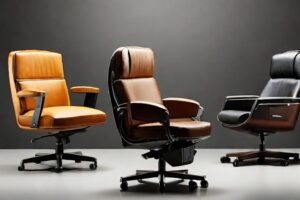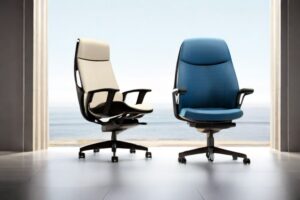
As remote work continues to gain popularity, creating a comfortable and productive home office setup has become essential. Central to this setup is the chair you choose, as it plays a significant role in your overall health, comfort, and productivity. With numerous options available, selecting the right chair can be overwhelming. This guide will help you navigate the different types of chairs and provide insights on how to choose the perfect chair for your home office.
Understanding the Importance of a Good Office Chair
Before diving into the various types of chairs, it’s important to understand why investing in a good office chair is crucial. Sitting for extended periods can lead to numerous health issues, including back pain, neck strain, and poor posture. A well-designed office chair can alleviate these problems by providing proper support and promoting good ergonomics. This not only enhances comfort but also boosts productivity and overall well-being.
Types of Chairs for Home Office
1. Ergonomic Office Chairs

Description: Ergonomic chairs are designed to provide maximum support and comfort, tailored to the natural curvature of the spine. They typically feature adjustable components, including seat height, armrests, backrest, and lumbar support.
Pros:
- Excellent support for back and neck
- Adjustable features allow for personalized comfort
- Promotes good posture and reduces the risk of musculoskeletal issues
Cons:
- Can be expensive
- May require some time to adjust and configure
Best For: Anyone looking for long-term comfort and support during extended work hours.
2. Executive Chairs

Description: Executive chairs are typically larger and more cushioned, offering a luxurious feel. They often come with high backs, ample padding, and additional features such as reclining mechanisms and adjustable armrests.
Pros:
- High comfort level with plush padding
- Often aesthetically pleasing and professional-looking
- Provides good support for back and shoulders
Cons:
- Can be bulky and take up more space
- Generally more expensive
Best For: Professionals seeking a blend of comfort, style, and functionality.
3. Task Chairs

Description: Task chairs are versatile and functional, designed for short to medium-duration tasks. They are usually lightweight, with basic ergonomic features and a focus on mobility.
Pros:
- Affordable and widely available
- Suitable for various tasks and activities
- Easy to move around
Cons:
- May lack advanced ergonomic features
- Not ideal for long hours of continuous use
Best For: Individuals who need a simple, budget-friendly chair for shorter work sessions.
4. Mesh Chairs

Description: Mesh chairs feature a breathable mesh backrest, promoting airflow and keeping you cool during long work hours. They often come with ergonomic features and adjustable settings.
Pros:
- Breathable material keeps you cool
- Lightweight and modern design
- Typically offers good ergonomic support
Cons:
- The seat cushion may lack sufficient padding
- Durability of the mesh material can vary
Best For: People who work in warmer climates or tend to get hot while sitting for long periods.
5. Kneeling Chairs

Description: Kneeling chairs encourage an open hip angle by positioning the thighs at a forward tilt. This design aims to reduce lower back strain and promote better posture.
Pros:
- Promotes good posture and core strength
- Reduces pressure on the lower back
- Unique and beneficial for short periods
Cons:
- Can be uncomfortable for long durations
- Limited adjustability
Best For: Individuals looking for an alternative seating option to improve posture and core strength for short tasks.
6. Balance Ball Chairs

Description: Balance ball chairs incorporate an exercise ball into the chair design, encouraging active sitting and promoting better posture and core engagement.
Pros:
- Encourages active sitting and movement
- Can improve posture and core strength
- Fun and unique seating option
Cons:
- Limited support and stability
- Not suitable for all-day use
Best For: Those seeking an alternative seating option to promote movement and engagement during short work sessions.
7. Standing Desk Chairs

Description: Designed for use with standing desks, these chairs, also known as perching stools or sit-stand chairs, allow you to alternate between sitting and standing positions.
Pros:
- Supports an active work style
- Reduces the risks associated with prolonged sitting
- Adjustable height to match standing desks
Cons:
- May take time to get used to
- Limited support compared to traditional chairs
Best For: Individuals using standing desks who want the flexibility to sit or perch as needed.
Key Features to Consider When Choosing a Chair
When selecting a chair for your home office, consider the following features to ensure you find the best fit for your needs:
1. Adjustability
Look for chairs with adjustable seat height, backrest, armrests, and lumbar support. This allows you to customize the chair to your body and work habits, ensuring optimal comfort and support.
2. Lumbar Support
Proper lumbar support is crucial to prevent lower back pain. Choose a chair with adjustable lumbar support to maintain the natural curve of your spine.
3. Seat Comfort
The seat should be well-padded and contoured to provide comfort over long periods. Consider the seat depth and width to ensure it fits your body size.
4. Backrest
A high backrest provides better support for your upper back and shoulders. Look for a chair with a reclining feature to allow for movement and relaxation during breaks.
5. Armrests
Adjustable armrests help reduce strain on your shoulders and neck. They should be set at a height where your arms can rest comfortably with your elbows at a 90-degree angle.
6. Material
Consider the chair’s material for both comfort and durability. Mesh chairs offer breathability, while leather or faux leather provides a luxurious feel. Fabric chairs can be comfortable and come in various styles and colors.
7. Mobility
If you need to move around frequently, choose a chair with smooth-rolling casters and a swivel base. This allows you to easily reach different areas of your workspace without straining.
8. Durability
Invest in a chair built to last. Check reviews and warranties to ensure the chair’s quality and longevity, especially if you plan to use it for several hours a day.
Conclusion
Choosing the right chair for your home office is a crucial decision that can impact your comfort, health, and productivity. By understanding the different types of chairs available and considering key features such as adjustability, lumbar support, and material, you can make an informed choice that best suits your needs.
Whether you opt for an ergonomic chair for its superior support, a mesh chair for breathability, or a balance ball chair for active sitting, the right chair can make a significant difference in your work-from-home experience. Take the time to assess your specific requirements and invest in a chair that will provide the comfort and support you need to stay productive and healthy.
